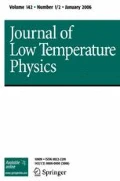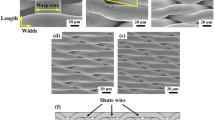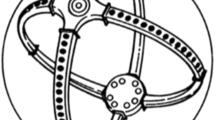Abstract
In order to investigate the wicking performance of cryogenic propellants within metallic screens for space liquid acquisition devices, a modified one-dimensional macroscopic model is introduced. The model is successfully verified by the experimental data of both isothermal and superheated wicking. Dutch twill weave 200 × 1400 in the warp direction is chosen as the screen object. Three cryogenic propellants such as hydrogen, oxygen and methane are selected as the working fluids. The wicking performances at different thermal conditions (isothermal and superheated) and gravity levels (Earth, Mars, Moon and space) are investigated. Results show that the wicking velocity and maximal wicking height both have a negative correlation with the gravity and superheated degree. The wicking performance deviation between different fluids or different superheated conditions increases as the gravity decreases. LH2 always has the fastest initial wicking velocity, but its wicking performance rapidly deteriorates to the worst at superheated conditions due to its strongest ability of heat transfer. The wicking performance of LO2 is the worst at isothermal condition, but becomes better than that of LH2 at superheated condition. Wicking of LCH4 always has the largest maximum wicking height and performs the best among the three propellants under the same condition.









Similar content being viewed by others
Abbreviations
- A :
-
Surface area (m2)
- c :
-
Specific heat capacity (J kg−1 K−1)
- c p :
-
Specific heat capacity at constant pressure (J kg−1 K−1)
- D c :
-
Equivalent capillary diameter (m)
- Gr:
-
Grashof number
- g :
-
Gravity (m s−2)
- H :
-
Height of sample (m)
- h :
-
Wicking height (m)
- h fg :
-
Latent heat of evaporation (J kg−1)
- K :
-
Permeability (m2)
- k :
-
Coefficient of heat transfer (W K−1 m−2)
- q :
-
Heat exchange capacity (J)
- \(\dot{q}\) :
-
Heat transfer rate (W)
- l :
-
Characteristic length (m)
- m :
-
Mass (kg)
- Nu:
-
Nusselt number
- n :
-
Empirical coefficient
- Pr:
-
Prandtl number
- T :
-
Temperature (K)
- t :
-
Time (s)
- u :
-
Wicking velocity (m s−1)
- W :
-
Width (m)
- α v :
-
Expansion coefficient (K−1)
- ΔT :
-
Temperature difference, superheat degree (K)
- δ :
-
Thickness (m)
- θ :
-
Contact angle (°)
- λ :
-
Thermal conductivity (W m−1 K−1)
- µ :
-
Dynamic viscosity (Pa s)
- v :
-
Kinematic viscosity (m2 s−1)
- ρ :
-
Density (kg m−3)
- σ :
-
Surface tension (N m−1)
- ϕ :
-
Porosity (–)
- e:
-
Evaporation
- eq:
-
Equilibrium
- g:
-
Gas
- l:
-
Liquid
- max:
-
Maximum
- S:
-
Shute
- s:
-
Solid
- W:
-
Warp
- DTW:
-
Dutch twill weave
- LAD:
-
Liquid acquisition device
- LH2 :
-
Liquid hydrogen
- LO2 :
-
Liquid oxygen
- ECD:
-
Equivalent capillary diameter
- LCH4 :
-
Liquid methane
- LN2 :
-
Liquid nitrogen
- SHD:
-
Superheated degree
References
Y. Ma, Y. Li, K. Zhu, Y. Wang, L. Wang, Investigation on no-vent filling process of liquid hydrogen tank under microgravity condition. Int. J. Hydrogen Energy 42(12), 8264–8277 (2017)
J.T. Howell, J.C. Mankins, J.C. Fikes, In-space cryogenic propellant depot stepping stone. Acta Astronaut. 59(1–5), 230–235 (2006)
S. Mustafi, C. DeLee, J. Francis, X. Li, D. McGuinness, C.A. Nixon, L. Purves, W. Willis, S. Riall, M. Devine, A. Hedayatb, Cryogenic propulsion for the titan orbiter polar surveyor (TOPS) mission. Cryogenics 74(3), 81–87 (2016)
S. Tucker, L. Hastings, D. Haynes, An overview of NASA’s in-space cryogenic propellant management technologies, in Thermal Fluid Analysis Workshop, Huntsville, AL, 2001
L.J. Hastings, D.W. Plachta, L. Salerno, P. Kittel, An overview of NASA efforts on zero boil off storage of cryogenic propellants. Cryogenics 41(11–12), 833–839 (2001)
D.J. Chato, Cryogenic fluid transfer for exploration. Cryogenics 48(5), 206–209 (2008)
C.H. Delee, P. Barfknecht, S. Breon, R. Boyle, M. DiPirro, J. Francis, J. Huynh, X. Li, J. McGuire, S. Mustafi, J. Tuttle, D. Wegel, Techniques for on-orbit cryogenic servicing. Cryogenics 64, 289–294 (2014)
J.A. Goff, B.F. Kutter, F. Zegler, B. Bienhoff, F. Chandler, J. Marchetta, Realistic near-term propellant depots: implementation of a critical spacefaring capability, in AIAA Space 2009 Conference and Exposition, Pasadena, 14–17 Sept 2009
S.C. Brock, R.K. Grove, R.O. Sloma, D.L. Balzer, Y. Brill, G.A. Yankura, A survey of current developments in surface tension devices for propellant acquisition. J. Spacecr. Rockets 8(2), 83–98 (1971)
D.A. Fester, A.J. Villars, P.E. Uney, Surface tension propellant acquisition system technology for space shuttle reaction control tanks. J. Spacecr. Rockets 13(9), 522–527 (2012)
S. Darr, J. Hartwig, Optimal liquid acquisition device screen weave for a liquid hydrogen fuel depot. Int. J. Hydrogen Energy 39(9), 4356–4366 (2014)
S. Dominick, J. Tegart, Orbital test results of a vaned liquid acquisition device, in 30th AIAA/ASME/SAE/ASEE Joint Propulsion Conference. Indianapolis, 1994
D.J. Chato, Technologies for refueling spacecraft on-orbit, in AIAA Space 2000 Conference and Exposition, 2000
J.R. Tegart, S.L. Driscoll, L.J. Hastings, Fluid acquisition and resupply experiments on space shuttle flights STS-53 and STS-57. Marshall Space Flight Center, Alabama, NASA/TP-2011-216465, 2011
J. Hartwig, D. Chato, J. McQuillen, Screen channel LAD bubble point tests in liquid hydrogen. Int. J. Hydrogen Energy 39(2), 853–861 (2014)
J.W. Hartwig, Y. Kamotani, The static reseal pressure model for cryogenic screen channel liquid acquisition devices. Int. J. Heat Mass Transf. 99, 31–43 (2016)
Symons E P. Wicking of Liquids in Screens. NASA TN D-7657, 1974
F.T. Dodge, The new “dynamic behavior of liquids in moving containers” (Southwest Research Inst., San Antonio, 2000)
L.J. Hastings, L.G. Bolshinskiy, R.G. Schunk, A.K. Martin, R.H. Eskridge, B.D. Hamill, C.F. Gomez, A. Frenkel, G. Grayson, M.L. Pendleton, Thermal integration of a liquid acquisition device into a cryogenic feed system. Marshall Space Flight Center, USA, NASA/TP-2011-216474, 2011
J. Hartwig, S. Darr, Influential factors for liquid acquisition device screen selection for cryogenic propulsion systems. Appl. Therm. Eng. 66(1), 548–562 (2014)
C. Camarotti, O. Deng, S. Darr, J. Hartwig, J.N. Chung, Room temperature bubble point, flow-through screen, and wicking experiments for screen channel liquid acquisition devices. Appl. Therm. Eng. 149, 1170–1185 (2019)
N. Fries, K. Odic, M. Conrath, M. Dreyer, The effect of evaporation on the wicking of liquids into a metallic weave. J. Colloid Interface Sci. 321(1), 118 (2008)
Y. Ma, Y.Z. Li, L. Wang, G. Lei, T.X. Wang, Investigation on isothermal wicking performance within metallic weaves for screen channel liquid acquisition devices (LADs). Int. J. Heat Mass Transf. 135, 392–402 (2019)
Y. Ma, D. Zimnik, M. Dreyer, Y.Z. Li, Investigation on cryo-wicking performance within metallic weaves under superheated conditions for screen channel liquid acquisition devices (LADs). Int. J. Heat Mass Transf. 141, 530–541 (2019)
Y. Grebenyuk, M.E. Dreyer, Wicking of liquid nitrogen into superheated porous structures. Cryogenics 78, 27–39 (2016)
N. Fries, M. Dreyer, An analytic solution of capillary rise restrained by gravity. J. Colloid Interface Sci. 320(1), 259–263 (2008)
N. Fries, M. Dreyer, The transition from inertial to viscous flow in capillary rise. J. Colloid Interface Sci. 327(1), 125–128 (2008)
F.A.L. Dullien, Porous Media: Fluid Transport and Pore Structure (Academic press, Cambridge, 2012)
R. Masoodi, K.M. Pillai, Wicking in Porous Materials: Traditional and Modern Modeling Approaches (CRC Press, Boca Raton, 2012)
NIST, Chemistry, WebBook. NIST standard reference database number 69. October 2011 release, http://webbook.nist.gov/chemistry/
J. Hartwig, J.A. Mann, A predictive bubble point pressure model for porous liquid acquisition device screens. J. Porous Media 17(17), 587–600 (2014)
J.W. Hartwig, Y. Kamotani, The static bubble point pressure model for cryogenic screen channel liquid acquisition devices. Int. J. Heat Mass Transf. 101, 502–516 (2016)
Acknowledgements
This work was supported by the National Natural Science Foundation of China [51906194, 51876153] and the Research Fund of State Key Laboratory of Technologies in Space Cryogenic Propellants [SKLTSCP1810].
Author information
Authors and Affiliations
Corresponding author
Additional information
Publisher's Note
Springer Nature remains neutral with regard to jurisdictional claims in published maps and institutional affiliations.
Rights and permissions
About this article
Cite this article
Ma, Y., Li, Y., Xie, F. et al. Investigation on Wicking Performance of Cryogenic Propellants Within Woven Screens Under Different Thermal and Gravity Conditions. J Low Temp Phys 199, 1344–1362 (2020). https://doi.org/10.1007/s10909-020-02446-x
Received:
Accepted:
Published:
Issue Date:
DOI: https://doi.org/10.1007/s10909-020-02446-x




